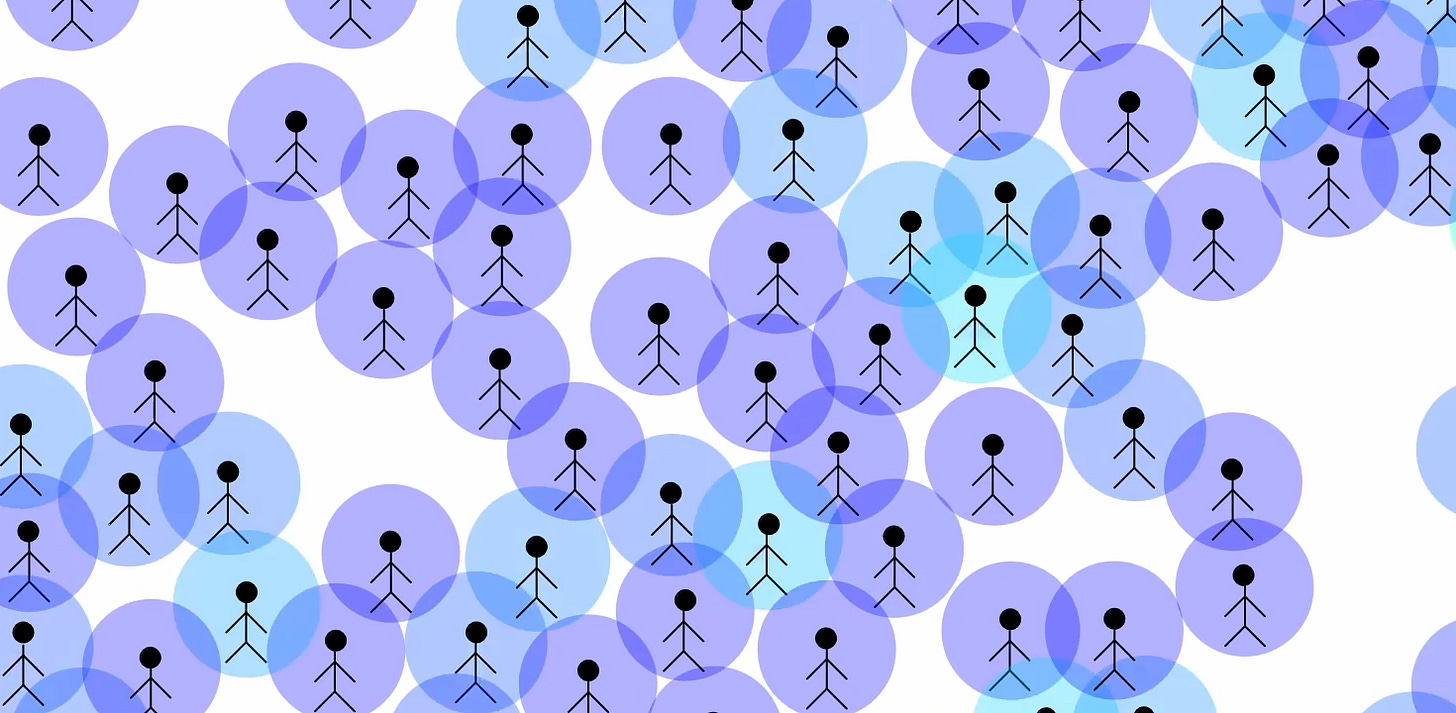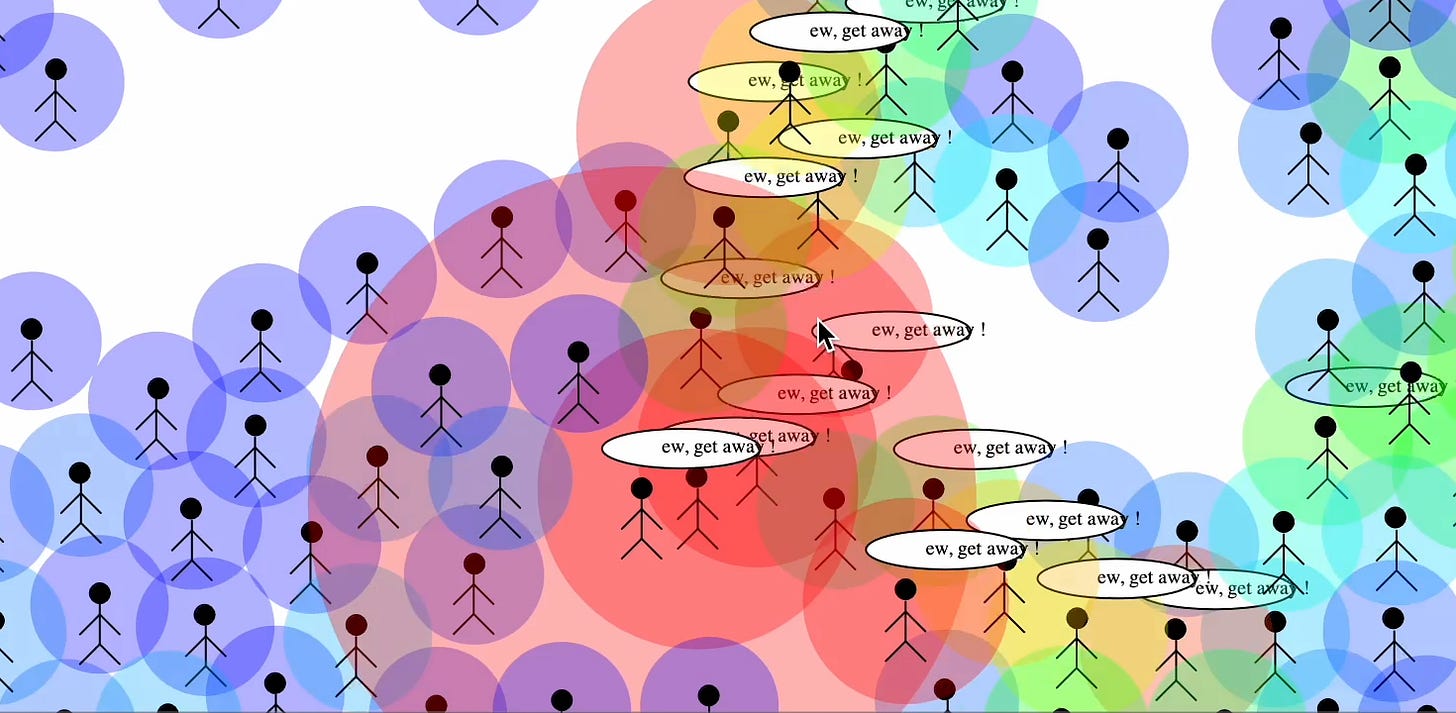Crowds and Power 👥⚡: The state of an individual before joining a crowd
CaP NDC-01-01 : Exploring "Crowds and Power" by Elias Canetti through examples and simulations. NDC : Nature and Dynamics of a Crowd is part 1/3 of this series.
The following analysis is done to understand and simulate different concepts presented in the book Crowds and Power by Elias Canetti.
About Elias Canetti
Elias Canetti won a Nobel Prize in Literature for "for writings marked by a broad outlook, a wealth of ideas and artistic power". Crowds and Power beautifully delves into the nature and dynamics of Crowds through different religions and cultures across the world throughout history.
Introduction to this newsletter series of Crowds and Power and the initial focus on Crowds
The first in this series of analyzing Crowds and Power, we are going to explore the basic nature, formation and dynamics of a crowd. Here, Canetti showcases crowds to have a life of their own. The concept of a Crowd itself being the main topic in discussion here. In later parts of this series we will explore the aspect of Power through Crowds.
What is it going to be like trying to understand the concepts in this book ?
Trying to understand these concepts will look like a person trying to figure out how different groups of ants work together. Each group of ants here has a specific job and the survival of these ants depends on how well they can collaborate and understand the other groups’ dynamics. Here the group is a Crowd.
Human society being a complex structure of cultures doesn’t enjoy the luxury of simple subdivisions used to explain the hierarchies in an ant colony. Due to this complexity, we are first going to try and understand how these different groups or Crowds are formed and what their collective behavior looks like.
Let’s try to understand the nature of an individual before they become part of a crowd.
The state of an individual before joining a crowd
The state of fear
The initial state of an individual before they are part of a crowd is the state of fear. In this state the individual’s personal space is not to be trifled with. It is a state in which the individual is most comfortable and their surroundings are no one else’s but their own. This can translate into the individual’s safe space.
When there is a breach in this space, the individual can retaliate. Canetti calls this state, The Fear of Being Touched.
The Fear of Being Touched
Before an individual becomes part of a crowd, they reside in a space where they feel most safe and content. We explore this aspect of space and of breaching the space with the p5.js sketch below. We shall try to explore and understand all the concepts in this book in the same way.
Introduction to the Sketch (1)
The following sketch demonstrates an individual establishing a Minimum Distance which they try to maintain from the other individuals in the scene. With this we can simulate the idea of safe space. If anyone else breaches this space, the individual retaliates with a
“ew, get away !”
expressing displeasure. Ever so mild displeasure of someone barging into your room without knocking. The mouse cursor below is a movable individual with whom we try to breach the personal space of others. What fun ?! Right ?!! This individual, who is backed by the mouse cursor has their head is falling off and kind of looks like Nearly Headless Nick.
Sketch 1.1: Fear of Being Touched (attacking personal space)
Parameters of the Sketch
Apart from Minimum Distance parameter, we have Number of Particles as the other relevant parameter in this sketch. Rest of the parameters are animation and rendering related.
Understanding Minimum Distance
As the other stick figures disperse when the mouse comes close to them, each individual who’s private space is breached says, “ew, get away !”. This reaction is completely acceptable when the person going around is literally holding their head in their hands.

Repulsion
This sketch helps us understand the initial state of a person and the unwillingness to let go of personal space, which is important to them. Each individual is in a state of flux and disorientation of some sort at this point. This is because, at any point if anyone else is too close to an individual, their initial reaction is to repel. As the individuals disperse and bump into the rest of the crowd, the other individuals react, causing mass hysteria which is resembled by the red glows which we see.

Increasing personal space to an extent where co-existence becomes problematic → Introduction to Sketch (1.2)
In the simulation below, we are increasing the minimum distance required by each stick figure to be kept from each other and as we trigger this behavior we see some interesting effects.
Sketch 1.2: Fear of Being Touched (when too many people need too much personal space)
Updating the Minimum Distance parameter
In the above example we update the Minimum Distance parameter value to 100 from 50. This is double the amount from the previous time causing each of the individuals to require double the amount of safe space they require. This causes each person goes in a frenzy in a small space trying to keep distance from each other.
Too much personal space
Each individual in the above sketch is now actively trying to move away from everyone else at all times and because of this no individual is able to return to a place of calm. The personal space required by each person is too much. This is causing a mass hysteria where not enough space can be occupied by any of the people, making all of them struggle in place.
The necessity to draw bounds beyond what might be more than what everyone can afford together causes all individuals to continuously struggle.
Personal space and privilege
On a more pensive note, the characteristics and the amount of personal space required by a person can be a product of nature or nurture. Different societies and classes within these societies would have different experiences of personal space.
Someone who grew up in the slums where families of more than 4-5 would live in a small space would say that the personal space nurtured by a well to do individual could be enough for the whole family. Someone who has never had to do a day’s of work to live a good life would find the idea of 5 people staying in one room to be appalling.
This makes us think a little more deeply about how privilege and the bounds of an individual’s personal space as a product of nature or nurture.
Transition from the state of fear to that of being a part of a crowd
Now that we have looked at how an individual functions when they aren’t a part of a Crowd and when they are in the state of fear (The Fear of Being Touched), we can now move forward to understand how the same individual could join a Crowd and become one with a group of people. When an individual is part of a Crowd, the fear has dissipated and they act in the spirit of the crowd. As long as the Crowd has a goal, it shall be together and work together and keep the individuals of the Crowd engaged, with everyone moving towards the same goal.
In the next post we will delve into The Essence and Formation of Crowds. We will try to understand how Crowds are formed and how depending on a lot of internal and external factors the life or a Crowd is determined.
Crowds and Power 👥⚡: The Essence and Formation of Crowds (2)
The following analysis is done to understand and simulate different concepts presented in the book Crowds and Power by Elias Canetti.





